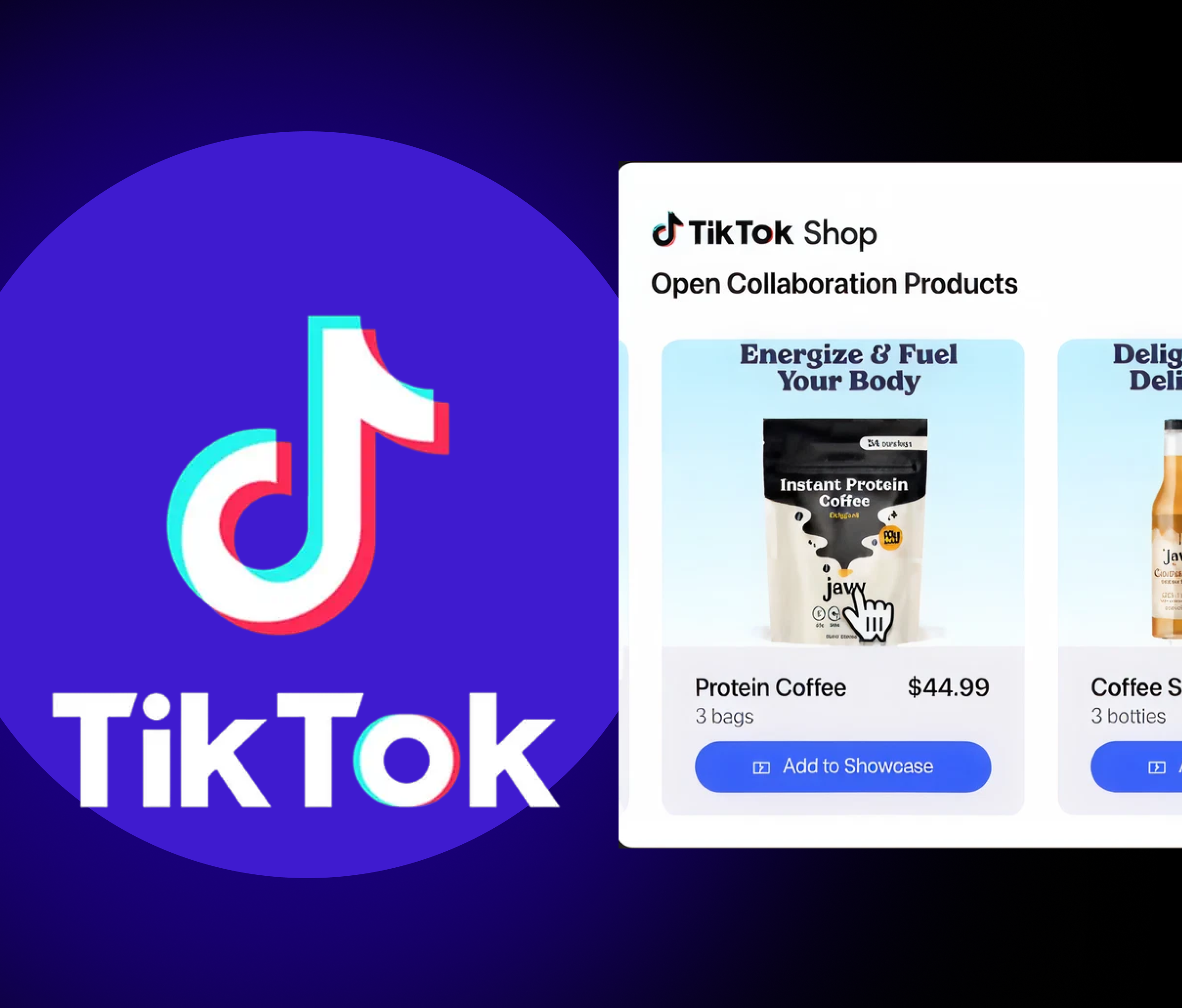TikTok has changed the way consumers discover and engage with brands, offering entertainment, social proof, and shopping in one seamless experience. With over 1.5 billion active users and the highest engagement rate of any social platform, TikTok is a goldmine for ecommerce brands.
The launch of TikTok Shop has made it even easier for brands to promote their products, reach new audiences, and drive direct sales. One of the most powerful features is the affiliate program, which allows brands to partner with creators who promote products through authentic, native content.
In this guide, we’ll break down everything you need to know to set up a TikTok Shop affiliate program, collaborate with the right creators, and leverage the platform to drive sales.
What is TikTok Shop?
TikTok Shop is TikTok’s native ecommerce solution that allows brands, creators, and affiliates to sell products directly within the app. It turns the platform into a full-funnel shopping experience, letting users discover, learn about, and purchase products without ever leaving TikTok.
TikTok Shop is now available in several regions, including the US, UK, Vietnam, Thailand, Singapore, Malaysia, the Philippines, etc.
Here are the features of TikTok Shop that make it valuable for brands:
- Shop tab and product showcase: Merchants and creators can showcase products via their TikTok profile, complete with a shopping bag icon. Users can browse curated collections, product listings, and reviews all within the app.
- In‑feed and live shopping: Products can be shoppable directly from regular videos and Live-stream sessions. Users can tap on pinned products or embedded product tags to purchase instantly.
- Affiliate & Shop ads programs: Creators can earn commissions through TikTok Shop's affiliate program by promoting products. Brands can also use Shop Ads and showcase ads to increase visibility and drive conversions directly inside TikTok.
- Fulfillment & secure checkout: TikTok manages logistics through options like Fulfilled by TikTok and integrates with trusted third-party payment processors to ensure a quick and secure purchasing experience.

Read about TikTok for Business to explore all the tools and features available for ecommerce brands to make money on TikTok
How does TikTok Shop affiliate marketing work?
TikTok Shop’s affiliate program connects brands (known as sellers) with content creators who promote your products through engaging videos to increase your brand’s visibility and sales. Whenever a viewer buys using their unique link or code, the TikTok Shop creator gets a commission.
Read about the different ways you can run affiliate marketing on TikTok.
When you join TikTok Shop’s affiliate program, you can partner with affiliates and creators who earn commissions on sales they drive. The platform also gives you access to real-time metrics, insights, and tools to track performance and optimize your strategy.
For shoppers, TikTok Shop removes friction from the buyer journey. When a creator recommends a product, the viewer can tap to learn more, see reviews, and check out, without needing to switch apps or search manually. This seamless experience boosts conversion rates and makes TikTok Shop a powerful driver of affiliate revenue.
Looking to improve your affiliate marketing strategy? Pick up affiliate marketing tips from our guide.
Why should ecommerce brands run an affiliate marketing program on TikTok?
Affiliate marketing is one of the best digital marketing strategies for ecommerce brands to drive performance-based sales, expand reach through creator partnerships, and build social proof at scale.
Running an affiliate marketing program on TikTok offers ecommerce brands an opportunity to tap into one of the most diverse social media platforms, where you can monetize authentic content to drive real purchase intent.
Here are some reasons why TikTok should be a key part of your affiliate marketing strategy:
- Active user base: TikTok boasts over 1.5 billion monthly active users. Plus, its smart algorithm connects you with users who are most likely to be interested in your products.
- Authenticity and trust: TikTok thrives on raw, unpolished content. This creates a perfect environment for affiliate creators to share honest product experiences that shoppers will trust.
- Access to diverse creator networks: From nano-influencers to viral creators, TikTok’s ecosystem supports affiliates across every niche. This means you can easily tap into highly engaged communities that align with your brand.
- Integration with TikTok Shop: With TikTok Shop, users can discover, consider, and purchase products without leaving the app. Affiliate links and product tagging streamline the buyer journey and reduce friction.
- Highest engagement rate: With an average engagement rate of 2.65%, the TikTok app leads all social media platforms. Your brand gets seen, shared, and talked about.
- Insights for optimization: TikTok provides detailed insights into your affiliate campaigns. You'll know exactly how to optimize your strategy.
- Opportunity for impulse purchases: 55% of TikTok users have made impulse purchases on the platform. This presents a golden opportunity to boost your TikTok sales conversion.
How to set up a TikTok Shop affiliate program for your ecommerce brand
Getting started with the TikTok Shop affiliate program as a seller is easy. Brands need to pick the right TikTok Shop plan based on their goals, list products within their TikTok Shop, identify affiliates, and offer them helpful resources to get started.
Here’s a step-by-step guide for ecommerce entrepreneurs to set up their TikTok Shop affiliate program:
Step 1: Define your goals and pick the right TikTok Shop plan
Focus on what you want to achieve with your TikTok Shop affiliate marketing. What is your goal? It could be to:
- Boost your brand awareness
- Drive more traffic to your ecommerce store
- Increase your sales
Having a clear target will help you understand which TikTok Shop plan is right for your brand. There are 3 types to choose from:
- Shop plan: A one-size-fits-all option with a single commission rate for all your products. Ideal for keeping things simple and hassle-free.
- Open plan: With this plan, you can create specialized commission structures for specific products, while allowing all creators to promote them.
- Targeted plan: This allows you to handpick creators to promote selected products. Perfect for running exclusive campaigns or working with niche TikTok influencers for ecommerce.
Tip ⛄: Don't hesitate to start with one plan and switch it up later. As you learn more about what works for your brand, you can always adjust your strategy.
Step 2: Narrow down your target audience
Now that you have your goals, it's time to identify your TikTok audience. Who's most likely to love your products? Teens? Busy parents? Or fitness enthusiasts?
Here are a few things you can do to find your ICP on TikTok:
- Existing customers: Analyze current customers and look at who's already buying. What do they have in common?
- Define ideal customer: Based on that, picture your ideal customer. What do they like? What challenges do they face? How is your product solving that problem? Where are they from?
- Browse TikTok content and hashtags: Once you have a good idea about them, check out popular trends and hashtags to understand what engages them.
For instance, if you're targeting fitness enthusiasts, you might want to follow hashtags like #fitness and #homeworkout, and take a close look at the kind of content being posted and getting high engagement.
The more specific you can be about your target audience, the more effective your TikTok shop affiliate marketing strategy will be.
Step 3: Identify the right affiliates
Finding the right affiliates for your TikTok marketing strategy is like choosing the best players for your team.
When searching for affiliates, consider these key criteria:
- Niche fit: Look for creators whose content aligns with your brand and products.
- Engagement rate: High engagement often matters more than follower count.
- Content quality: Their videos should be creative, authentic, and well-produced.
- Audience demographics: Their followers should match your target customer profile as per the age group, location, gender (if needed), and more.
- Brand values: Choose affiliates who share your brand's values and ethos.
Bonus tip ⛄: Don't overlook micro-influencers. They often have more engaged audiences and can be more cost-effective for your campaign.
Step 4: Negotiate terms and conditions
Once you've identified potential affiliates, it's time to provide clear, fair terms and conditions.
Here are key points to cover:
- Commission structure: Decide on a fair percentage or flat rate for each sale. Consider offering tiered commissions to incentivize higher performance.
- Payment terms: Clarify when and how affiliates will be paid. Will it be monthly? After a certain sales threshold?
- Content guidelines: Outline what type of content you expect. This helps maintain brand consistency while allowing creative freedom.
- Exclusivity: Decide if you want exclusivity or if affiliates can work with competing brands.
- Duration: Set a timeframe for the partnership. This allows both parties to reassess and adjust as needed.
- Performance expectations: Establish clear KPIs. What constitutes success for both you and the affiliate?
Remember, transparency is key. Clear terms prevent misunderstandings and set the stage for productive, long-lasting influencer partnerships.
Step 5: Equip your affiliates with the right resources
Set your affiliates up for success by providing essential tools and information. This helps them create compelling content that aligns with your brand and resonates with their audience.
Key resources to provide:
- Product information: Share details about features, benefits, and unique selling points.
- Brand guidelines: Offer clear guidance on tone, style, and messaging.
- Content ideas: Suggest themes, hashtags, or calls to action that have worked well.
- Visual assets: Supply high-quality images or videos for use in their content.
- Communication channels: Establish open lines for questions and feedback.
Read more about how you can help your affiliates create better content.
Bonus tip: Incorporate user-generated content to increase interaction and engagement with your material.
Step 6: Choose the right affiliate marketing tool
As your TikTok Shop affiliate program grows, managing it manually can quickly become overwhelming.
A good affiliate marketing tool for TikTok streamlines operations, improves tracking, and enhances overall performance.
When selecting an affiliate marketing tool, consider these key features:
- Seamless integration: Works smoothly with TikTok Shop and your ecommerce platform.
- Real-time analytics: Offers detailed data on performance and ROI.
- Customizable commissions: Allows flexible commission rates.
- Reliable payment system: Provides secure, automated payments.
- Fraud and code leak protection: Generates unique, single-use discount codes to prevent coupon abuse.
Remember, the right tool should align with your specific needs and goals.
Examples of TikTok Shop Affiliate Marketing Programs
Tabs Chocolate
Tabs Chocolate is a brand that sells pleasure-boosting dark chocolates. Due to the market, they were facing a unique hurdle. Their product wasn't permitted to be advertised on popular social media channels.
With influencer marketing as their best shot at success, they needed a way to manage a massive group of creators efficiently and track their performance with room for zero errors.
Tabs Chocolate used Social Snowball to manage their influencer programs and set up a streamlined system:
- They consolidated all their influencer programs under one roof, making it easier to organize and track campaigns.
- Social Snowball made it easy for the brand to generate and manage one-time use discount codes at scale, allowing them to track micro-influencer campaigns and reduce any coupon code leaks.
- They set up a Discord for the micro-influencers they partner with, giving them access to support and resources like top-performing videos for inspiration.
- Tabs Chocolate used the bulk-payment feature on Social Snowball to distribute payments on time to all their creators, saving tons of admin time and keeping their creators happy.
By joining the TikTok Shop affiliate program, Tabs Chocolate saw over 22M monthly views on creator content. Using Social Snowball to manage it allowed the brand to drive 9.8x ROI on their influencer campaigns, increase influencer marketing revenue by 17%, and save 10+ hours weekly on admin work.

SooSlick
SooSlick, a shapewear brand, identified that launching a Tiktok Shop affiliate program can help them reach their target audience without being overly promotional.
Here’s how SooSlick brought their vision into reality:
- They partnered with TikTok creators and encouraged them to create content that feels genuine and entertaining, and helps connect with a broader audience without being salesy.
- They uploaded their entire product catalog to TikTok Shop, giving creators more choices and allowing them to feature more products in their videos, which consequently increased their sales.
The results:
- Over 200 million video views on TikTok, leading to viral brand exposure.
- $1 million in incremental sales within the first 30 days.
- Highest-ever sales volume, customer reach, and revenue.

Triquetra Health
Triquetra Health is a supplement brand focused on plant-based wellness, selling products like magnesium, zinc, and elderberry. With a growing Shopify store and a lean marketing team, they wanted to build a scalable affiliate program that could drive consistent revenue without high overhead or manual processes.
Here’s how Triquetra Health set up their TikTok Shop affiliate program:
- They used Social Snowball to automate affiliate onboarding, code creation, and attribution, eliminating the need for custom development or third-party plugins.
- Every new customer was instantly turned into an affiliate post-purchase, creating a flywheel of word-of-mouth growth with zero friction.
- They used Safelinks (one-time-use discount codes) to track each sale accurately and prevent code misuse or leaks across TikTok and other platforms.
- The team leveraged bulk payouts to streamline creator payments and avoid time-consuming manual accounting.
With a better system, Triquetra Health was able to drive 10x ROI on affiliate-driven sales, with 12% of total revenue attributed to their affiliate program. The brand was able to scale their program to 1,000+ active affiliates with minimal internal effort.

Ready to add another revenue stream with TikTok Shop’s affiliate program?
TikTok Shop’s affiliate program offers a powerful way for ecommerce brands to increase reach, drive sales, and tap into creator-led content that feels native to the platform. With the right setup, from choosing commission structures to curating high-converting creators, you can turn TikTok into a high-ROI sales channel.
To scale your efforts, you need more than just a solid strategy. You need the infrastructure to support it. Managing affiliate approvals, tracking performance, and issuing payouts manually can limit growth. Tools like Social Snowball are built to solve this.
With automated onboarding, real-time tracking, and seamless payout workflows, Social Snowball helps you manage TikTok Shop affiliates efficiently.

Frequently Asked Questions
What are the two types of sellers on TikTok?
The two types of sellers on TikTok are:
- Individual sellers: These are typically content creators or small businesses who make money online by selling products directly through their TikTok accounts.
- Business sellers: These are established businesses, often with their own ecommerce platforms, who use TikTok Shop to expand their reach and sales channels.
How to add affiliate products in TikTok Shop for free?
Here’s how you can add affiliate products in TikTok Shop as a seller:
Step 1: Create a TikTok Shop seller account
Go to TikTok Shop Seller Center and register your business.
Step 2: Add your products
Upload your product listings under the “Products” section with details, pricing, and photos.
Step 3: Join the affiliate program
Go to “Affiliate Marketing” in the Seller Center and click on “Create Affiliate Campaign”.
You can choose between:
- Open plan: Any creator can apply to promote your product and earn a commission.
- Targeted plan: You select specific creators to promote your product.
Step 4: Set commission rates
You decide how much to pay creators per sale (e.g., 10% per order). You only pay after a successful sale, so there's no upfront cost to add affiliate products.
Step 5: Review & approve creators (for targeted plan)
For “Targeted” campaigns, you'll manually review applications. For “Open” campaigns, creators can start promoting immediately after approval.
If you run your business on Shopify, you can integrate your inventory more seamlessly with the social media platform by installing the TikTok app.
What documents are required for business sellers' verification?
To be verified as a business seller on TikTok Shop, the following documents are required:
- Business registration certificate.
- Tax identification number.
- Government-issued ID of the business owner or an authorized representative.
- Proof of address (utility bill or bank statement).
- Bank account information for payments.
Please note that exact requirements and eligibility vary depending on the country and specific TikTok Shop policies. Look into the latest TikTok Shop seller guidelines for the most accurate information.



.png)






